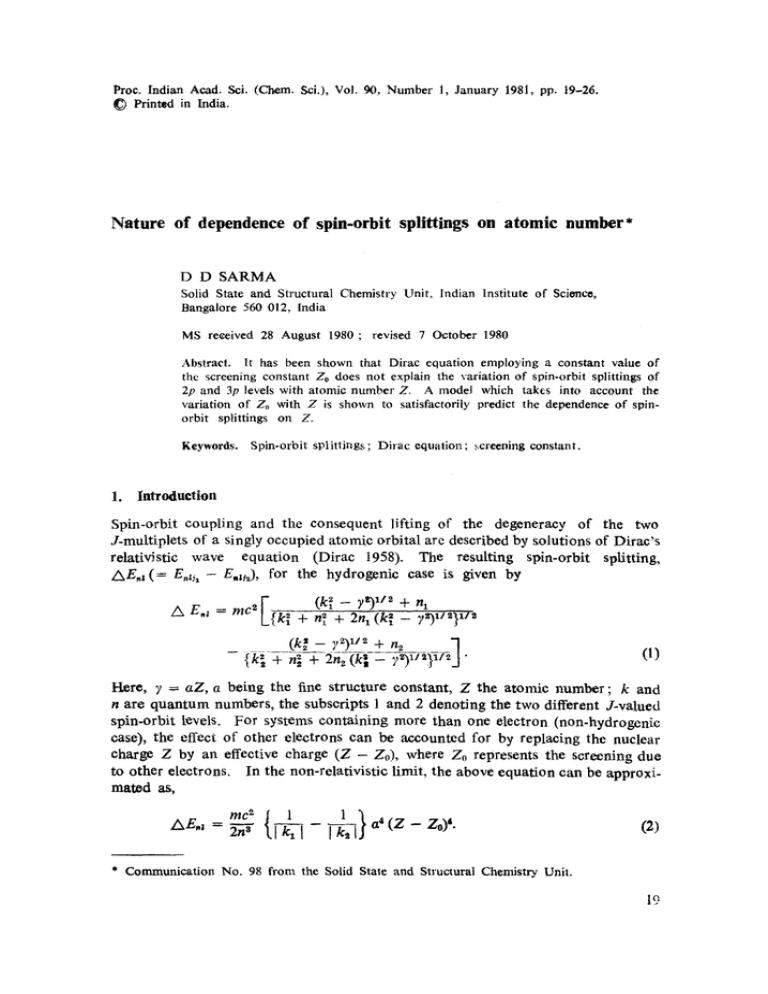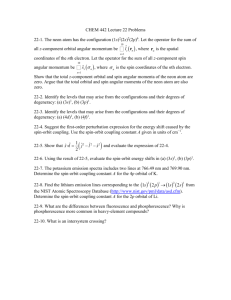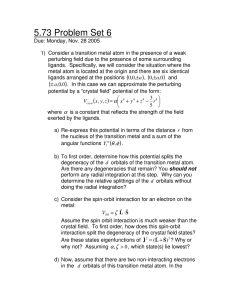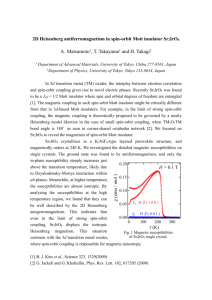Prec. Indian Acad. Sci. (Chem. Sci.), Vol. 90, ... ~) Printed in India.
advertisement

Prec. Indian Acad. Sci. (Chem. Sci.), Vol. 90, Number 1, January 1981, pp. 19-26.
~) Printed in India.
Nature of dependence of spin-orbit splittings on atomic number*
D D SARMA
Solid State and Structural Chemistry Unit, Indian Institute of Science,
Bangalore 560 012, India
MS received 28 August 1980; revised 7 October 1980
Abstracl. It has been shown that Dirac equation employing a constant value of
the screening constant Z0 does not explain the variation of spin-orbit splittings of
2p and 3p levels with atomic number Z. A model which takes into account the
variation of Z0 with Z is shown to satisfactorily predict the dependence of sNnorbit splittings on Z.
Keywords, Spin-orbit sPlittings; Dirac equation; .,:creeningconstant.
1. Introduction
Spin-orbit coupling and the consequent lifting of the degeneracy of the two
J-multiplets of a singly occupied atomic orbital arc described by solutions of Dirac's
relativistic wave equation (Dirac 1958). The resulting spin-orbit splitting,
A E , z ( = E , ~ - E,~j0, for the hydrogenie ease is given by
~, E., = m e ~ {k~ + n~ + 2n~ (k~ - 7~)1/~} 1/2
(k~ - y2)1/~ + n2
I-Iere, 7 -= a Z , a being the fine structure constant, Z the atomic number; k and
n are quantum numbers, the subscripts 1 and 2 denoting the two different J-valued
spin-orbit levels. For systems containing more than one electron (non-hydrogenie
case), the effect of other electrons can be accounted for by replacing the nuclear
charge Z by an effective charge (Z - Zo), where Zo represents the screening due
to other electrons. In the non-relativistic limit, the above equation can be approximated as,
mc~ {
1
1 } a4(Z - Zo)'.
(2)
* Communication No. 98 from the Solid Stale and Structural Chemistry Unit.
19
20
D D Sarma
This equation still use3 the spherical coulombie potential with art effective (Z - Z o) e
charge at the nucleus. Sm~ll deviations from the spherical nature of the potential
can be accommodated by writing equation (2) as,
AE~, = a (z - zo)',
(3)
where a is the parameter accounting for the non-sphericity of the potential. Thus
(1) and (3) have been employed to understand the dependence of experimental
/X,E,z values (from x-ray photoelectron spectroscopy) on Z in related series of
metal oxides (Sarma and Rao 1980). These equations (with a constant Z 0 value)
could not, however, explain why /XEsp in transition metal oxides (Z = 22-29)
vary linearly with the atomic number (Rao et al 1979), the difference between
the experimental and the calculated values of /~E2~ in these systems being much
beyond the experimental error. Large deviations of experimental AE2p from
values calculated from (1) have also been found in transition metals (Barrie
et al 1974). Such deviations are noticed (Sarma and Rao 1980) for other levels
(e.g., 3d and 4d) in the case of metal oxides over narrow ranges of Z. These
deviations cannot be explained on the basis of (1)and (2)which employ a
constant Z 0 value for all elements for a given level (nl). It, therefore, becomes
necessary to find a functional relation between Z o and Z which leads to satisfactory results for/XE,~ over the entire range of Z values. In this paper, we have
shown how the screening constant Z 0 varies with Z due to various electron-electron
interactions and then, compared the observed AE,z values with those predicted
by equation (1) incorporating a Z0 (Z) term based on our model. The results are
indeed most encouraging and provide an insight into the nature of screening.
5. M~thodology
Using the experimental values of /kE~p and /kE3p from the literature (Bearden
and Burr 1967), Z 0 values for the elements were calculated from equation (I),
the error in Z o being estimated from the errors in the values of the spin-orbit
splittings. The uncertainties in Z 0 values were rather large in the case of 2p levels
for elements with Z < 20 and Z > 75; for the 3p level, it was large for
elements with Z < 38 and Z > 83 and also for Z = 57-70. We, however,
retained/kE~ of Ar (Z = 18) as this value is known with great accuracy from U V
photoelectron spectroscopy. In the region of Z = 11-19, the Z o value is extremely
sensitive to small changes in the /kEz~ values; although the absolute error of
/kE~ over this region is not large, it leads to large errors in Z 0 values and
thus, this region was not included in the data set for the 2p level. The Z o values
thus obtained are plotted against Z in figures 1 and 2 for the 2p and 3p levels
respectively. The figures clearly illustrate how Z 0 varies markedly when we
consider a wide range of elements; furthermore, the nature of variation of Z o
varies from one level to another.
In order to provide a simple heuristic model, we propose that there are three
types of interactions that should be taken into account to explain the variation
of screening constant with Z. These contributions are: (i) screening due to
electrons closer to the nucleus than the level in question, (ii) coulombic contribution of outer electrons to screening and (iii)spin-spin interaction of the core
Spin orbit splittings on Z
3'G
21
--
3.4
3.2
0
N
3.0
2,8
20
L
I
t
I
32
44
Z
56
68
'80
Figure 1. Plot of Zo (2p) against Z. The solid line is the least-square fit to th9
data points according to equation (4).
9.0
8-5
8.0
I
I
I
t
38
46
54
62
Z
I
70
1
I
78
86
Figure 2. Plot of Zo (3p) against Z. The errors in Zo values arc shown for the
points which have been used for the least-square fit procedure ; for other Z0 values,
the errors are very large. The solid line is the least-squ~re fit according to equation (4) with only the first two terms.
hole with the outermost open shell. The largest contribution would be due to
(i) a n d would vary f r o m one level to a n o t h e r ; we shall denote this by a constant Z~, since this contribution essentially represents screening as is usually
understood. C o n t r i b u t i o n f r o m ( i i ) w o u l d invoNe electron-electron interaction
including direct and exchange terms and would vary with the number o f outer
electrons. Since it is impossible to depict the functional relationship o f these
interactions o n the outer electrons in a closed form, we have arbitrarily chosen
D D Sarma
22
to represent the effect of the interactions, where j denotes an outer level, hi,
the oeoupancy of the level j in the i-th element, E2, and E] are the energies of
the (nl) and j levels and 2" is a negative number. Similarly, we have chosen to
represent the spin-spin interaction by
s' exp [(e.',
-
~')/y],
where S~ is the spin due to unpaired electrons in the outermost valence level,
v, of the i-th element, Es are the energies and y is a negative number. The
weighting factors (E,*~ - E~)" and exp [(E,~ - E*,)/y] in these two interactions are
chosen to be different because of the different spatial dependence of these two
interactions. Both these factors approach a value of zero as the energy separation [between the levels (hi) and ] or v] becomes larger representing the limiting
behaviour of these interactions correctly.
The factor (E~z - El)" diverges as
E/ approaches the value of E~, in order to simulate the decreasing separation
between the electrons from two levels ; this represents the divergence of coulombic
interaction with decreasing separation. The exponential factor, exp [(E~ - E~)/y],
in the spin-spin interaction term has a limiting value of unity as E~ approaches
E,~ and thus, simulates this interaction as the electrons with the same spin are
forbidden to approach each other vei'y closely due to Pauli's exclusion principle.
Taking all these three terms together, the total screening constant Z 0 can be
written as,
Z 0 = Zg + A Z . ~' ( E ~~, -
Ej)' " + ~ S~exp[(E,~, -
E;)/y].
(4)
J
[n (4) we would expect A to be positive and B to be negative as the eleetronele0tron coutombie interaction is repulsive whereas the spin-spin interaction
stabilises the electronic state.
The various parameters in (4) were calculated for the 2p level by a least-square
fit (root mean square deviation = 0.022, correlation coefficient = 0.994) of the
Z 0 values obtained from experimental AEz, data (employing equation 1). The
parameters so obtained are as follows: Z,', = 2 . 6 5 2 9 ,
A =0.6685,
B=
- 1 . 1 5 9 4 6 , x = - 0 . 4 1 2 2 and y = - 3 8 4 - 5 . It is interesting to note that the
signs of A and B come out as expected, the latter showing a negati,ce sign. These
parameters were then used to calculate the Z o versus Z curve shown in figure 1.
The marked deereas~ in Z 0 in the region of Z = 25 is due to the spin-spin interaction term; the electron-electron repulsion term would only give a smooth
increase from Z o = 3.25 to Z o = 3"5 in the region Z = 20-40. The spin-spin
interaction term becomes dominant in the region of first-row transition metals
while it is negligible for Z > 40 due to negligible overlap between the core hole
and the valence level in this region.
The Z 0 values of 3p level obtained from experimental AEs, values (figure 2)
exhibits a behaviour entirely different from Z o (2p) values. In view of the large
uncertainties in these Z 0 (3p) data, we considered it appropriate to omit the spinspin interaction term in (4), since it would only account for small variations.
The parameters obtained by the least-square fit of (4) with the first two terms
Spin orbit splittings on Z
23
alone (root mean square deviation = 0.072, correlation coeffioient = 0.956) are
as follows:
Zg = 7.26072,
A = 1.22719
and x -- - 0 . 5 6 1 5 .
We see that Z, value of 3p is larger than that for 2p as expected. The value
of Z 0 for Ar (7.26) calculated f r o m these parameters is indeed very close to
the value of Z 0 obtained f r o m experimental AE~, value (7.28). The calculated
value of AE3p in the case of CI- is also close to the observed value (--~ 0.1 oV).
We should, however, note that spin-spin interaction may, indeed, become very
important in the region of Z = 19-37 giving rise to a significant decrease in Z o
values for these elements.
I f good data for AE3p were available, we feel certaAn
that equation (4) with spin-spin interaction term would predict the exact variation
of experimental Z o values.
3,
Results and discussion
In figures 3 and 4 we have shown how the values of spin-orbit splittings for 2p
and 3p levels calculated f r o m the Dirac equation [equation (1)] employing Z o
ooo _
, oo -
=oo400
0--
/ /
/.."7"
2,o
/
~
I
<f
--
I,_
20
I
1
I
32
44
.56
L___
68
80
Z
Figure 3. Plot of A E ~ values against atomic number Z. The solid line is the
calculated plot of /~E~ using Dirac equation incorporating Zo (Z) according to
equation (4). The inset shows the comparison between the values of AE~v predicted according to equation (I) (- - - -), equation (3) (--.--.--) with constant Zo and
the present model (the solid line); the experimental values are shown as solid
circles.
24
D D Sarma
500--
/
-
S/
z
200 L
58
~ 1
35
46/
42
45
I
1
I
55
65
75
Z
Figure 4. Plot of /XEz u values against Z. The solid line is the calculated values
of/XE3~ according to the present model. The inset shows the comparison between
the values of /XE3~ predicted according to equation (1) ( - - - - ) , equation (3)
(-- . . . . ) with constant Z0 and the present model (the solid line) over a narrow
range of Z ; the experimental values of ~E~p are shown as solid circ!es.
values given by (4) show excellent agreement with experimental data. In these
figures, we have also shown how the description of Z 0 given in terms of (4)
gives more reliable predictions of /XE~p and AE3p than when we use (1) or (3)
with constant Z o values. With constant Z o values (1) and (3) give much poorer
fits for both ~E2p ( Z range, 20-75) and AE3 ( Z range, 35-83) as can be seen
from the root mean square deviations given in table 1.
The parameters of (4) for the 2p level mentioned earlier were employed to
calculate the spin-orbit splittings (ZxE2,) in some of the lighter elements ( Z = 11-19).
The calculated and experimental values are shown in table 2. We clearly see
the success of this model describing the total screening constant f r o m this table.
The description of Z o given in (4) appears to be able to explain certain specific
variations of spin-orbit splittings found in transition metal systems. Thus, (4)
predicts that transition metal ions like Fe ~+, Co g+ and Co 3+ should have a higher
/XE~, when they are in the high-spin state than in the low-spinstate. The predicted difference varies between 0 . 4 and 0.8 eV compared to the experimental values
which show differences of 0.4--0.6 eV, /XE2, values calculated for Cr~O s and
Spin orbit splittings on Z
25
Table 1. Root mean square deviations in least-square fits of/~E2~ and
values employing different equations.
Level
Range of Z
Equation (1) tin)
Equation (3) C*)
/~Esp
Present model
2p
20-75
0.771
5.400
0.432
3p
35-83
1-094
2-133
0.803
ca) The value of constant Z0 which gave minimum deviation is used in the least-square fit.
Table 2. Calculated and experimental spin-orbit splitting values (in eV) for some
elements.
Z
11
12
13
14
15
16
17
18
19
19
Element
Na
Mg
AI
Si
P
S
CI
Ar
K
K+
Calculated
AE~,
0'3
0.3
0'5
0.9
1 "4
1"6
1"8
2.2
3'0
2-8
Experimental
A E ~ (a)
0.3
0"3
0.4
1.0
1.0
1.0
2-0
2"1
2.7
2-7
t~) The experimental values of AE2~ are taken from Shirley et al (1977).
CrO a show a differences of about 0.4 eV between the two r
to an
observed difference of 0"8 eV. A lowering of AE2p by 0.7eV is predicted
for the d o state of Mn (Mn 7+) compared to that in Mn z+. An increase
of AE2~ by 0.2 eV is predicted in going from Mn to MnO, while the observed
change is 0.4 eV. Equation (4) also predicts differences between spin-orbit
splittings of elements and their compounds, but we woutd not expect a quantitative agreement in view of the differences in bonding, crystal field effects and so
on.
Acknowledgement
The author is thankful to Professor C N R Rao for suggesting the problem and
also for his kind help throughout the course of this work,
26
D D Sarma
References
B~rie A, Drummond I W and Herd Q C 1974 J. Electron. Spectrosc. ReL Phenom. 5 217
Bearden J A and Burr A F 1967 ~ev. Mod. Phys. 39 125
Dirac P A M 1958 Principles of quantum mechanics Ch. XI (Oxford University Press)
Rao C N R, Sazma D D, Vasudevaxt S and Hegde M S 1979 Prec. R. Soc. London A367 239
Sarraa D D and Ran C N R 1980 J. Electron Spectrosc. EeL Phenom. 20 25
Shirley D A, Martin R. L, Kowalczyk S P, McFeely F R and Ley L 1977 Phys. Rev. BI5 54




